|
This mini-FAQ contains a lot of information,
including extensive discussions on: (1) the modem
hardware (and the items bundled with it, such as the pack-in
games), (2) the file
sharing features of GB KISS (which doesn't necessarily require the
modem, and includes sharing text messages as well as game data), a brief
look into the catalog of GB KISS games,
and (4) a look at what makes a GB KISS
cartridge special. Ooops, I forgot about the most important
thing... in an effort to keep this article as confusion-free as possible,
please familiarize yourself with the handy glossary of
GB KISS terms, since you may already be wondering what, if any,
difference there is between GB KISS, GB KISS LINK, GB KISS MAIL,
etc. Finally, to round things out, the
success and / or failure of GB KISS is considered.
On March 6, 1998 (a week after the release of Nectaris GB), Hudson Soft of Japan released GB KISS LINK
-- one of the most intriguing Gameboy peripherals ever released (yes, Gameboy Advance peripherals
included). So, you ask, what type of peripheral was GB KISS
LINK ? Well, GB KISS LINK was an infrared modem that allowed folks to connect their
Gameboy (with a GB KISS cartridge installed) to a personal computer
(running PC Windows 95). This allowed gamers to
|
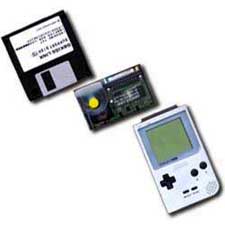 |
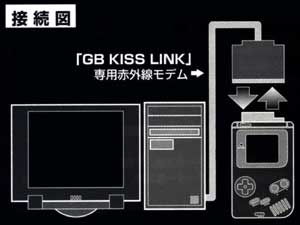 |
|
|
An infrared modem that
allows you to transfer game data between a Gameboy cartridge (GB KISS compatible)
and a personal computer ( PC
Windows 95 ) ...who knew? GB KISS LINK came with
two 3.5" floppy diskettes: GB KISS utilities / drivers on
the first, and 29 mini-games ( ? ) for Gameboy on
the second disk (not pictured). |
|
transfer data (i.e.
game save states, custom maps created with the map editor, exclusive content downloaded from
Hud- son's website, etc.) between their PC and Gameboy cartridge. Yes, you heard that right...
the original 1989 Gameboy, which was
considered ancient technology well before 1998, was still getting
innovative (others might call it "gimmicky" ) software and
hardware support whilst other, less fortunate handhelds (i.e. NEC's
PC-Engine GT, Atari's Lynx, Sega's Game Gear, etc.) had long been
abandoned in the graveyard of gaming devices.
Speaking of ancient technology, Gameboy Color was released in 1998, the same year
as GB KISS LINK and Nectaris GB. It was the first (and only) Gameboy
design to feature an infrared (IR) communication port. When I first heard about
file sharing via GB KISS, I assumed it was designed with Gameboy Color's
IR port in mind. Then I
realized that Nintendo did not release Gameboy Color until October 1998
(seven months after the release of Nectaris GB and the GB KISS
LINK). Then a friend told me that the Japanese version of Pocket
Bomberman (which was released in December of 1997) featured GB KISS functionality as well.... Well, it was
at this point that I knew that I was totally confused: how exactly did GB KISS work, since the
original Gameboy (and 1996's Gameboy Pocket update) did not have an
infrared (IR) communication port?
|
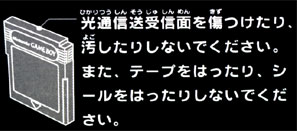 |
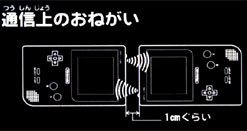 |
|
|
LEFT
: Infrared (IR) communication port built into the top of all GB KISS
cartridges. RIGHT : Positioning
Gameboys for a GB KISS file transfer. They must be no more than 1
centimeter apart, hence they are "kissing" each
other. Yay! |
|
All the evidence ( page
41 page
42 ) points to one solution: GB KISS games have an IR port built into the
cartridges themselves; this allows GB KISS games to fully function
with any Gameboy handheld
(GBA SP, GBA, GB Color, GB Pocket, GB original, etc.). However, the GB
KISS features may be incompatible with Super Gameboy (i.e. the Gameboy
adapter for Super Famicom / Super Nintendo -- a Japanese site noted this
incompatibility, but I have yet to verify it) and / or Gameboy
Player (i.e. the Gameboy adapter for Nintendo's GameCube).
Still, I
am confused: being the nerd that I am, I
inspected my Nectaris GB cartridge very carefully and found no
evidence of an IR port (in fact, the cart's external appearance was
identical to that of a standard, generic Gameboy cartridge). When I
get a chance, I am going to open the cartridge. That should set the
record straight. Also, once I acquire a second copy of Nectaris GB,
I will be able to test the GB KISS features first hand.
|
| |
Glossary
of GB KISS Terms: |
TOP
|
It is very easy to get confused
with all the different features of GB KISS and the terminology applied
to each of them. This glossary is my attempt to define some
general terms in a simple, straightforward manner. To get a feel
for the more nuanced and finer details of GB KISS, please read the
entire mini-FAQ.
| "GB KISS" is a term created
by Hudson
Soft, and yes, it implies that two Gameboy cartridges are "kissing" each
other--but instead of exchanging saliva, they are exchanging data. "GB
KISS" is a broad term that refers to "wireless, infrared file
transfer." It is most commonly used in reference to cartridge
<--> cartridge file sharing, since that was the most common applica-
tion of GB KISS technology (i.e. sharing user-created maps from Pocket
Bomberman or Nectaris GB ). |
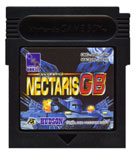
|
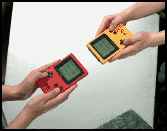
|
|
GB
KISS Cartridge
with built-in IR port |
Two Gameboy cartridges
"kissing"
(sharing data),
hence "GB KISS"
|
| All
GB KISS games included a utility for managing and transferring files (both
game data and text messages). Each GB KISS cart allocated
six memory slots for game data (i.e. save states, user-created
maps, con- tent downloaded from internet) and 18 slots for text
messages. Yes, that's right, with "GB KISS MAIL" you
could compose text messages (both kana /
kanji and Roman alphabet available) and manage your mailbox. Then, with GB KISS, you could
send (and receive) messages from your friends. |
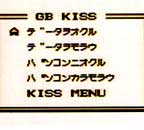
|
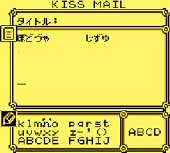
|
|
GB KISS UTILITY: Send & receive
files / messages from friends
|
GB KISS
MAIL: Compose messages & manage mailbox. |
|
Finally, "GB KISS LINK" was an infrared modem that you connected
to your personal computer, and its' sole purpose was to allow you to
transfer files between a GB KISS cartridge and a PC (in other words, it
allowed the Gameboy to "kiss" the PC). As the diagram on the far
right indicates, exclusive game content (i.e. extra levels) could be
downloaded from Hudson's website, saved onto your PC, and then transferred to Gameboy
via the GB KISS LINK modem. (PC Windows 95) |
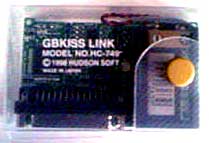
|
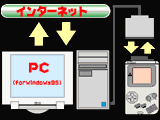
|
|
GB KISS LINK:
Modem hardware
|
PC
and cartridge are "kissing" |
|
| |
HARDWARE
UP-CLOSE: GB KISS LINK MODEM |
TOP
|
As you might expect, the GB KISS LINK
(Hudson Model # HC-749) was sold as a bundled package including several items: the modem itself, a
clear plastic case to protect the modem and two 3.5" floppy diskettes.
The first floppy disk contained special utilities / drivers to install on
a PC running Windows 95. The second disk contained files for 29
mini- games (developed by Hudson, these games are discussed in the
next section). The pictures below suggest that the GB KISS LINK modem was a fragile
item and that it certainly wasn't designed for rugged use (as you would
expect from handhelds and most of their accessories). The female
parallel port connector was mounted directly onto the IC board; the circuits
and electronic components on the board were exposed; and only a thin flexible
case was provided to shield GB KISS LINK from abuse. The
modem, which received and transmitted infrared signals to GB KISS cartridges,
required a
|
 |
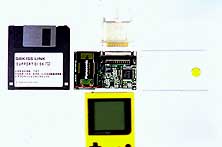 |
|
|
The
GB KISS LINK modem came in a thin plastic envelope that snapped shut
with a cute yellow button. A 9-volt battery (not
pictured) would rest on the IC board below this yellow button.
The image on the far right reveals an
unidentified item, located directly above the GB KISS LINK,
that I have not seen in any other picture nor mentioned in any
document. |
|
standard 9-volt battery (006P). I do not know the modem's
power consumption rate, but I would expect battery life to be average
(unless the modem lacks an "off" switch and is constantly
draining the battery). The GB KISS LINK had to be connected to a
PC via a parallel port cable (remember the good old days before USB?)
and the picture below (right) illustrates how this parallel port cable
connected to the modem itself. The modem was
designed to remain in it's plastic envelope at all times (except when
the battery needed to be changed), so there are openings in the case
near the parallel port connector and the IR port (located on the
opposite side of the parallel port connector?). Look closely at the image
below (left) you can see that the 3.5" floppy disk containing the drivers / utilities is labeled "GB KISS
LINK SUPPORT DISK" (Windows 95). This PC application for GB KISS
remains a mystery to me. At minimum, I would expect the PC
|
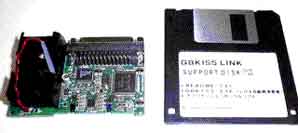 |
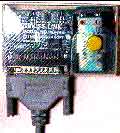 |
|
|
LEFT
: GB KISS
LINK without its' protective case (female parallel port connector is
in upper right corner; black plastic compartment for 9-volt battery
is empty). 3.5" floppy diskette containing the drivers /
utilities that had to be installed on the PC. RIGHT : During
use, GB KISS LINK remained in its' protective case. Here we see a
parallel port cable connected to GB KISS LINK. This modem used a
9-volt battery ( on the right, under the yellow button ). |
|
utility
to offer all of the options for managing and
transferring data as those found on the Gameboy's GB KISS utility
(here are the GB KISS MENU OPTIONS on the Gameboy -- translations
welcome). The PC version, however, would be able to save and
archive countless files (unlike the limited storage capacity of a
Gameboy cartridge). Also, the PC utility might offer some
specialized features for accessing the internet and downloading (perhaps
even UPLOADING) game content. For now, this is the only image of the PC
interface that I have been able to find:
|

|
|
|
GB KISS
LINK application for PC (Windows 95)
|
|
This screenshot of the PC utility is not
particularly helpful. Since I don't possess the GB KISS LINK modem
or any of its documentation, I am hoping someone else will be able to
fill in the gaps. I have been trying to get my hands on this item
(or anything related to it) for years, but they are difficult to come
by. For example, I have yet to see GB KISS LINK listed in any US, UK, or
Japanese online auctions. If you can help me out in any way,
please contact
me. |
| |
GB
KISS LINK: Pack-In
Games |
TOP
|
As I noted in the previous section, the
GB KISS LINK modem was bundled with two 3.5" floppy
diskettes. The second disk contained 29 mini-games for play on the
Gameboy (I have yet to verify that the 29 games were all unique and not
simply variations). The mini-game disk is never pictured in the
promotional photos, which is odd because companies usually
want consumers to feel like they are getting their money's worth.
And "getting your money's worth" was the very reason Hudson
included games in the GB KISS LINK bundle -- so gamers would actually be
able to use their new modem immediately (assuming they had at least one GB
KISS Gameboy cart, that is).
How lame (and disappointing) would it
have been to get the GB KISS LINK and not be able to use it because you
have no files to transfer (especially fresh, new content)?
Ultimately, I do not think Hudson created a lot of web-exclusive down-
loads
for games, so the pack-in games
served an important function (i.e. at the time of the modem's initial
release, perhaps there were 1-3 downloads available, although I can only
confirm one for Nectaris GB). Not that the pack-in mini-games were stellar,
mind you, but
at least they provided a pretext for actually using the modem to obtain new
content. Plus, once a mini-game was saved onto a Gameboy
cartridge, you could use GB KISS to share it with your friends (again,
assuming they owned at least one GB KISS cartridge). I don't have info on
all 29 mini-games (if there actually were 29 unique games, that is), but I was lucky enough to
find a handful of
reviews and screenshots from a Japanese website -- S.
Noddy's Homepage . Many thanks go out to S.
Noddy ( I dig that picture of him ! ) for documenting these games and
providing great screenshots! The six GB KISS mini-games profiled below are CANNON BALL, SAME GAME KISS,
MINI STASOL, PUZZLE GAME, WORM and ??? ( モグってナンボ、オヤジでドカン
).
| CANNON BALL
is a clone of Capcom's Buster
Bros. (a.k.a. POMPING WORLD in Japan). In this version, though, your
character's sprite looks like a ... ? |
SAME GAME GB KISS
is a simplified version of
Hudson's own game (a series of games, in fact) which
itself is a commercialized version of PC freeware. I read that the
PC freeware version had been a craze in Japan.
|
MINI STASOL
is a vertical shooter of
sorts. Remember, Hudson gave us the "Star Soldier"
series, which this mini-game is based upon. Get it?
STAr SOLdier.
|
PUZZLE
GAME |
モグってナンボ、オヤジでドカン
Bizarre... a boy (or
monkey?) climbing a palm tree (upper right) and
a vegetable ducking into a sewer pipe a la Mario Bros. Wait! That's the
same running vegetable featured in CANNON BALL.
|
WORM
Well, you should know this
one. At least the other mini-games listed above use sprites, WORM
is an ascii text game. |
Anyway, here's how the pack-in
games worked: First the mini-game files from the second floppy disk
were saved onto a PC. Then these files were transferred, via the GB KISS LINK modem,
to a GB KISS Gameboy cartridge. It is not entirely clear how this
works, since the mini-games would require some of
Gameboy's RAM -- RAM which, presumably, is already being used by whatever game is residing in the Gameboy at the
moment. Also, how would one access
these games? Transferring and storing a file into a cartridge's memory slot
is one thing, but accessing / playing a mini-game requires a user
interface (i.e. menu), among other things.
TRIVIA : Hudson
will recycle some of these mini-games as cell-phone games. Beginning
in 2000, Hudson shifted a lot of its energy and resources into
"mobile gaming" and developed a new business plan that focused
on providing cell phone content for gamers on several platforms
(initially, on the i-appli java-based cell phone platform and then
branching out to other, newer formats, such as VODAPHONE). Hudson
would eventually port faithful versions of its' PC-Engine HuCard catalog
to cell-gaming, including Nectaris, Bomberman, Super Star
Soldier, China Warrior, etc. |
| |
next
page: PART
II of the GB KISS MINI-FAQ |
TOP
|
The second part of this
mini-FAQ moves beyond
the hardware itself and examines how file sharing between cartridges
(and PCs, and the internet) is accomplished with the GB KISS utilities
(i.e. GB KISS MAIL). The commercial success (or failure) of
Hudson's GB KISS technology is discussed, followed by a brief look into
the catalog of GB KISS titles in Japan and North America (only one GB
KISS game was released in North America -- ROBOPON on Gameboy Color).
|
|